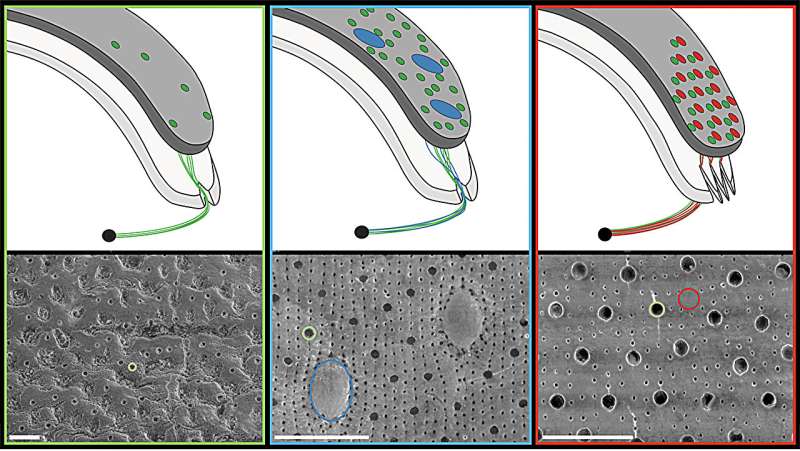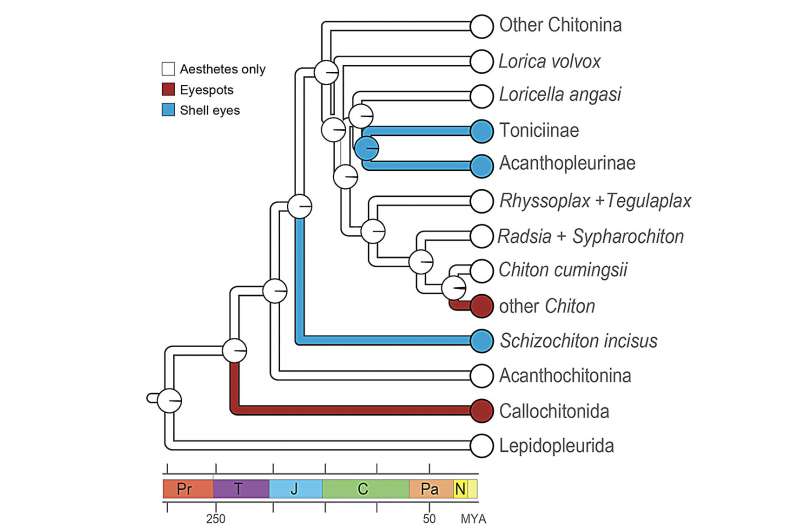This article has been reviewed according to Science X's editorial process and policies. Editors have highlighted the following attributes while ensuring the content's credibility:
fact-checked
peer-reviewed publication
trusted source
proofread
Unraveling the mystery of chiton visual systems

You'd probably walk past a chiton without even seeing it. These creatures often look like nothing more than another speck of seaweed on the crusty intertidal rocks. But it sees you. At least, if it's one of the species with eyes dotting its plate mail shell.
A team of scientists—led by Rebecca Varney at UC Santa Barbara's Department of Ecology, Evolution, and Marine Biology (EEMB)—discovered that some of these tough mollusks sport the most recently evolved eyes with a lens. What's more, the two kinds of eyes found in this group arose in four separate events. The researchers lay out what factors led to this peculiar arrangement in a paper published in Science.
Chitons are a curious group of marine mollusks. Though generally out of the public eye, they've made headlines for some remarkable feats. For instance, all species coat their teeth in the iron mineral magnetite, making them the hardest material created by a living organism. And at least one species uses the aptly named santabarbaraite, another iron mineral.
Despite chitons' relation to squid, snails, and scallops, their eyes aren't located on their soft bodies. Instead, many of their sensory organs are embedded directly into their segmented shell.
"I don't think there's any other animal that builds its eyes into its armor like a chiton does," said co-author Daniel Speiser of the University of South Carolina. The most numerous of these organs are called aesthetes, small sensory structures found in the outermost layer of the shells of all chitons. Scientists are still investigating their function, but if they do detect light, it would be on a very rudimentary level.
Aesthetes likely served as the basis for the two kinds of eyes that did evolve in some of these animals: the more complex shell eyes and the more numerous eyespots. Shell eyes are relatively large, and similar to human eyes, they have a lens that focuses incoming light to form an image on a photosensitive layer at the back. That said, in chitons this lens is formed of the mineral aragonite.
In contrast, the smaller eyespots in certain chitons function more like individual pixels or the compound eye of an insect, forming a visual sensor distributed over the chiton's shell. Chitons add these structures in new growth at the shell margin.
Senior author Todd Oakley studies how complex systems evolve and has used chiton eyes as an example in his classes as a Professor in EEMB. Co-author Speiser worked on chitons as part of his doctoral thesis before joining Oakley's lab as a postdoctoral researcher.
"We wanted to know: Is there something that we can identify that is guiding evolution in these different groups toward eyespots or toward shell eyes?" said lead author Varney, one of Oakley's current postdocs.
To get started, the team began constructing a chiton family tree using DNA from specimens preserved in co-author Doug Eernisse's global chiton collection, which now resides at the Santa Barbara Museum of Natural History. Co-authors Johanna Cannon and Morris Aguilar developed the molecular tools to probe the chiton genomes. Varney then mapped out which groups had eyespots and which had shell eyes, which yielded quite a surprise.
What the team had thought were two groups that each developed a different visual system ended up being four groups, with two pairs converging on the same structure. "We went in knowing there were two types of eyes, so we were not expecting four independent origins," Varney said. "The fact that chitons evolved eyes four times, in two different ways, is pretty amazing to me."
"It almost seemed too strange to be true," added Oakley. And the groups that arrived at similar structures weren't even the ones most closely related to each other. So what could've led to this curious setup?
Varney began poring over the differences between species in these groups to see if she could spot any clue as to what sent them toward different solutions to the same task. Fortunately for her, the number of slits on the margin of each shell segment is a trait used to distinguish different species of chitons. So this information is well documented, because it's included in every new species description.

Without context, this doesn't mean much, but a pattern began to emerge. Varney noticed that chitons with eyespots have a lot of slits—some upward of 20 notches in their head section. In contrast, chitons that evolved the larger shell eyes generally had about eight slits on this section. But again, how could this variation have sent the groups toward radically different adaptations, not once, but twice?
These notches serve as the conduit for nerves to pass from the chiton's shell into its body. So it seems that species with fewer slits evolve fewer, larger shell eyes that are more complex. In contrast, those with more slits were able to develop more numerous, slightly smaller eyespots, which are slightly simpler.
And even though the number of notches is diagnostic for the species, scientists don't know what dictates it. So the number of slits present when visual systems did develop seems to have influenced the type of visual system that evolved.
"Here we have a very clear demonstration in a natural system that evolution depends on what came before, even when what came before might seem completely unrelated," Oakley said.
The team decided to plumb further, using fossils to calibrate chiton evolution over time. This would give them a better estimate of when the four groups evolved their visual systems after chitons split from other mollusks around 450 million years ago.
They found that the shell eyes of chitons in Toniciinae and Acanthopleurinae are perhaps the most recently evolved lensed eyes, having arisen during the Cretaceous (150 to 100 million years ago). Shell eyes in the unrelated species Schizochiton incisus evolved in the Jurassic (250 to 200 Mya).
For context, most other instances of eyes with lenses evolved in the Cambrian, when animals were just beginning to diverge into major groups. Meanwhile, eyespots evolved as early as the Triassic (260 to 200 Mya) in one group and as late as the Paleogene (75 to 25 Mya) in another.
While some of these chitons have eyes capable of forming images, scientists are still investigating the extent of their visual perception. In a previous paper, Speiser's team demonstrated that the West Indian fuzzy chiton can resolve objects and respond to them. Their shell eyes send visual information for processing in a ring-shaped neural structure that goes around their whole body.
The way the optic nerves connect to this ring suggests chitons can locate an object based on the locations of the eyes that spot it. Speiser found that the chitons can resolve objects to an angle of around six degrees. "So while chitons have poor vision compared to our own, it seems like they really do 'see,'" he said.
This discovery confirms what scientists experience working with these chitons in the field. "When you are collecting chitons off rocks in the intertidal, you have to sneak up on the rock. Because if they see you, they will clamp down," Varney said. "And you can sit there with a nail file and try to pry the chiton off; you will lose."
Speiser and his colleagues are continuing to investigate chiton vision. It's a bit of a challenge. For one, "a video of a chiton and a picture of a chiton kind of look the same," Varney quipped. And when it comes to experiments, "chitons don't really have a reason to cooperate with you, so figuring out how to ask a chiton what it's looking at is a hard task."
Members of the team plan to investigate the genetic components of these kinds of eyes and where they came from. This pursuit will require focusing on only one or two species at a time.
We don't always know what trait will drive the path of evolution. Happenstance changes earlier on can have unexpected consequences in seemingly unrelated systems. "To study evolution as a whole, you have to, as much as possible, study these systems as a whole," Varney said.
More information: Rebecca M. Varney et al, A morphological basis for path-dependent evolution of visual systems, Science (2024). DOI: 10.1126/science.adg2689
Journal information: Science
Provided by University of California - Santa Barbara





















